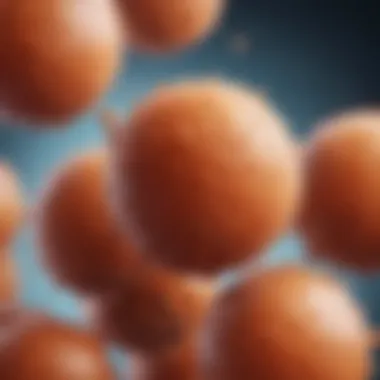Understanding the Three Phases of Chronic Myeloid Leukemia


Intro
Chronic Myeloid Leukemia (CML) is a complex blood cancer that primarily affects the bone marrow and blood. Understanding its mechanisms is crucial for effective treatment. CML progresses through three distinct phases: chronic, accelerated, and blast crisis. Each phase possesses unique characteristics that influence clinical management and patient outcomes. This article aims to provide a comprehensive guide to these phases, examining the clinical features, diagnostic criteria, treatment options, and overall disease progression.
Overview of Research Topic
Brief Background and Context
Chronic Myeloid Leukemia emerges from genetic mutations, particularly involving the Philadelphia chromosome. This mutation generates a fusion protein, BCR-ABL, contributing to uncontrolled cell proliferation. Unlike acute leukemias, CML typically progresses slowly, allowing time for signs to develop over years. Understanding these phases helps healthcare providers design tailored therapies according to disease stage, enhancing prognosis.
Importance in Current Scientific Landscape
With advancements in targeted therapies such as Imatinib, treatment of CML has evolved significantly. The introduction of these drugs has improved survival rates remarkably. Current research focuses on refining treatment protocols and understanding resistance mechanisms.
The classification of CML into stages offers insight into disease behavior and treatment response, making it vital for clinical research.
"The key to managing CML effectively lies in recognizing its phases and applying targeted interventions accordingly."
Methodology
Research Design and Approach
This article synthesizes existing literature and clinical guidelines on CML. It explores various studies to characterise each phase, highlighting diagnostic and therapeutic approaches.
Data Collection Techniques
Data were gathered through academic journals, clinical trials, and expert opinions from healthcare professionals specializing in hematology. A review of protocols established by organizations such as the National Comprehensive Cancer Network was also conducted, ensuring the inclusion of recent developments in CML management.
Foreword to Chronic Myeloid Leukemia
Chronic Myeloid Leukemia, commonly referred to as CML, is a complex condition that impacts both blood and bone marrow. Understanding CML is essential not only for healthcare professionals but also for patients and their families. This article seeks to highlight the significance of recognizing CML’s distinct phases and the implications they have on treatment and prognosis.
This introduction sets the stage for a deeper conversation about the disease’s clinical characteristics, risk factors, and potential treatment options. By decoding the progression of CML, health workers can tailor interventions effectively. Recognizing that timely diagnosis and management can significantly improve outcomes is crucial.
Overview of
CML is a type of cancer that arises from the overproduction of myeloid cells in the bone marrow. Unlike acute leukemias, which manifest aggressively, CML typically progresses slowly, often over several years. The disease is marked by the presence of the Philadelphia chromosome, a genetic abnormality that plays a key role in its development. Patients may experience symptoms such as fatigue, night sweats, and splenomegaly, which can often lead to a delay in diagnosis.
This lay of the land of CML encompasses understanding its biology, the stages of progress, and the unique aspects that classify it differently from other blood cancers. Awareness of these nuances aids in proper identification and response.
Epidemiology and Risk Factors
In terms of epidemiology, CML is less common than other types of leukemia. However, it presents a notable challenge to healthcare systems worldwide. The incidence rates are higher in adults, particularly between the ages of 50 and 70. While the exact cause of CML is not completely understood, several risk factors have been identified that can increase an individual’s chance of developing the disease.
- Age: Increased age is a significant factor.
- Gender: Males are generally found to be at a higher risk compared to females.
- Exposure to Radiation: Individuals exposed to high levels of ionizing radiation, such as survivors of Hiroshima and Nagasaki, have shown higher incidences of leukemia.
- Chemical Exposure: Long-term exposure to certain chemicals like benzene may contribute to CML.
- Genetic Predisposition: Family history of blood disorders can heighten one’s risk.
Understanding these elements is important for both preventative strategies and prompt diagnosis, ultimately improving the care of individuals who may be affected by CML.
"Awareness of the demographic factors associated with Chronic Myeloid Leukemia can facilitate timely intervention and improve patient outcomes."
Phase One: Chronic Phase


The Chronic Phase represents the initial and most stable phase of Chronic Myeloid Leukemia (CML). It is critical for understanding the disease as a whole and sets the foundation for subsequent phases. During this stage, the presence of the Philadelphia chromosome and the BCR-ABL fusion gene indicates the disease's onset. This phase typically lasts several years, often defining patients' quality of life and treatment response. Recognizing and accurately managing chronic phase CML impacts both short-term outcomes and the potential for progression to later stages.
Clinical Characteristics
In the Chronic Phase of CML, patients may often remain asymptomatic. When symptoms do present, they can vary widely. Common clinical features include fatigue, night sweats, and sometimes splenomegaly. A physical examination might reveal an enlarged spleen or liver, which can be significant in evaluating disease progression. Clinicians must consider these symptoms in the context of individual patient histories and other health conditions, facilitating more tailored management strategies.
Diagnosis and Lab Findings
Diagnostic criteria for the Chronic Phase include both cytogenetic and molecular evaluations. The gold standard is the cytogenetic detection of the Philadelphia chromosome through methods like karyotyping or fluorescence in situ hybridization (FISH). Additionally, polymerase chain reaction (PCR) can demonstrate the presence of BCR-ABL fusion transcripts. Regular blood tests will often reveal leukocytosis, where the white blood cell count is elevated, and a characteristic shift in the leukocyte population is observed. These findings are essential for confirming a diagnosis and guiding treatment decisions.
Treatment Approaches
Tyrosine Kinase Inhibitors
Tyrosine Kinase Inhibitors (TKIs) have revolutionized the management of CML, especially during the Chronic Phase. Drugs such as Imatinib, Dasatinib, and Nilotinib are central to therapy. Their primary mechanism involves targeting the BCR-ABL fusion protein, inhibiting its tyrosine kinase activity, and thereby preventing the proliferation of malignant cells. The key characteristic of TKIs lies in their specificity; they are designed to selectively inhibit cancer cells without significantly affecting normal hematopoiesis. The non-toxic profile and oral administration make them a beneficial choice for many patients. However, there are considerations regarding resistance and side effects, which can emerge over time.
Supportive Care
Supportive care is crucial in enhancing the quality of life for patients in the Chronic Phase. This approach focuses on alleviating symptoms and managing complications rather than directly targeting the leukemia. Key aspects include managing anemia and infections and monitoring for side effects of treatments. A significant characteristic of supportive care is its holistic focus—it addresses the overall well-being of the patient. Although such interventions do not directly cure CML, they can greatly improve the quality of life and ensure better adherence to primary treatments.
Prognosis and Monitoring
The prognosis during the Chronic Phase of CML is generally favorable, especially with early intervention and adherence to treatment plans. Regular monitoring through blood tests and molecular analyses is vital to assess the response to therapy. Patients often undergo regular monitoring for the achievement of major molecular response (MMR) or deeper responses. This helps guide ongoing therapy adjustments aimed at minimizing the risk of progression. Healthcare providers must collaborate closely with patients to ensure that they understand the importance of continuous follow-up and adherence to prescribed treatments.
Phase Two: Accelerated Phase
The Accelerated Phase of Chronic Myeloid Leukemia (CML) is a crucial component in understanding disease progression. This phase signals a transition from the more stable Chronic Phase, where patients often experience minimal symptoms. In contrast, the Accelerated Phase is marked by a change in the disease dynamics, characterized by an increase in blast cells and resistance to standard therapies. This is essential for healthcare professionals to recognize as it impacts treatment decisions and overall prognosis.
Identification of Accelerated Phase
Identifying the Accelerated Phase is primarily based on laboratory findings and clinical assessments. Clinicians often look for specific hematological criteria that indicate disease progression. One of the key indicators is an increase in the percentage of blast cells in the blood or bone marrow, typically ranging from 10% to 19%. Additionally, measuring the complete blood count can reveal other significant changes. Thrombocytopenia, or low platelet counts, and elevated white blood cell counts often accompany this phase. It is vital for medical teams to be vigilant during routine check-ups to detect these changes early.
Clinical Symptoms and Findings
Patients in the Accelerated Phase may present with various clinical symptoms. These can include increased fatigue, night sweats, fevers, and weight loss. There may also be splenomegaly, or an enlarged spleen, causing discomfort and abdominal fullness. As the phase progresses, symptoms can become more pronounced. Patients might also experience bone pain, which can indicate increased disease activity. Recognizing these symptoms timely can greatly influence management strategies.
Treatment Modalities
Re-evaluation of Therapy
Re-evaluation of Therapy is a critical step for patients in the Accelerated Phase. This process aims to assess the effectiveness of current treatment regimens, particularly those involving Tyrosine Kinase Inhibitors (TKIs). The key characteristic of this approach is the need for timely modifications to therapeutic strategies. When a patient shows a lack of response or develops resistance, alterations in medication can enhance treatment efficacy. The major benefit of this re-evaluation is that it allows for personalized adjustments that align with the patient’s unique disease profile. However, it poses challenges in balancing treatment intensity with potential side effects, necessitating careful monitoring.
Potential Clinical Trials
Engaging in Potential Clinical Trials represents another treatment strategy during the Accelerated Phase. These trials often explore new agents and combination therapies that may offer better outcomes. This approach is particularly valuable as existing treatments may show diminishing returns. A key characteristic of clinical trials is their ability to provide access to cutting-edge therapies, which may not be available to the general patient population yet. Participating in these trials can yield significant advantages, such as advanced research insights and possibly improved survival rates. However, patients need to weigh the uncertainties and potential risks involved in experimental treatments, as responses can vary widely.
Outcome Assessment
Assessing outcomes during the Accelerated Phase is crucial for determining the efficacy of treatment and informing next steps. This involves continuous monitoring of blood counts and the presence of blast cells, alongside evaluating the patient's overall health status. Regular follow-ups help clinicians to adjust strategies and improve quality of life. Understanding the velocity of disease progression paves the way for timely interventions and can significantly affect overall prognosis.


Recognizing the Accelerated Phase of CML and implementing timely treatment responses is essential in ensuring optimal patient outcomes.
Phase Three: Blast Crisis
The blast crisis phase of Chronic Myeloid Leukemia (CML) represents a critical juncture in the disease's progression. It is characterized by a significant increase in immature white blood cells known as blasts in the blood and bone marrow. This phase indicates a transition from the previous phases, where the disease becomes more aggressive and challenging to treat. Understanding the blast crisis is vital for healthcare professionals and patients, as timely recognition and appropriate management can significantly influence outcomes.
Characteristics of Blast Crisis
Blast crisis is marked by a surge of myeloid or lymphoid blasts, which affects normal hematopoiesis. Patients may present with various symptoms, including severe fatigue, fever, easy bruising, or bleeding. Often, individuals might also have splenomegaly or hepatomegaly, contributing to discomfort and complications. Laboratory findings typically reveal over 20% blasts in the peripheral blood or bone marrow. This phase not only compromises immune function but also heightens the risk of infections, which can be life-threatening if not addressed promptly.
Diagnosis and Assessment Techniques
Diagnosis during the blast crisis involves detailed laboratory analysis. Healthcare providers usually perform complete blood counts to assess blast levels. Cytogenetic studies, using techniques like fluorescence in situ hybridization (FISH), are essential for identifying chromosomal abnormalities, particularly the Philadelphia chromosome. Molecular assessments can also reveal the presence of BCR-ABL fusion gene, confirming the diagnosis of CML in blast crisis. Comprehensive diagnostic approaches allow clinicians to differentiate blast crisis from other types of acute leukemias, crucial for determining appropriate therapy.
Management Strategies
The management of blast crisis requires a multifaceted approach to optimize patient outcomes. It typically involves aggressive treatment options, primarily advanced chemotherapy and potentially hematopoietic stem cell transplantation.
Advanced Chemotherapy
Advanced chemotherapy plays a central role in managing blast crisis. This treatment often utilizes intensive regimens designed to eradicate the blast cells and re-establish normal hematopoiesis. A key characteristic of advanced chemotherapy is its ability to deliver high doses of chemotherapeutic agents like cytarabine and anthracyclines. Although this approach can be beneficial by rapidly reducing blast levels, it is also associated with significant side effects such as myelosuppression, which increases infection risk.
In the context of blast crisis, advanced chemotherapy is considered a first-line option, especially for younger and otherwise healthy patients. However, careful monitoring is crucial to manage toxicity and to modify treatment as necessary.
Hematopoietic Stem Cell Transplantation
Hematopoietic stem cell transplantation (HSCT) is another potential intervention for patients experiencing blast crisis. This approach involves replacing diseased bone marrow with healthy stem cells from a donor. A critical feature of HSCT is its potential to provide a curative treatment option in select patients. It is generally recommended for those with favorable prognostic factors who have achieved a temporary remission after chemotherapy.
The unique advantage of HSCT is its ability to restore normal blood cell production after destroying malignant cells. Nevertheless, this procedure carries risks, including graft-versus-host disease and complications related to immune reconstitution, which require careful evaluation before proceeding.
Challenges and Considerations
The challenges of managing blast crisis extend beyond the medical aspects. There is the psychological burden on patients and families and the need for supportive care. Additionally, the high risk of treatment resistance adds complexity to decision-making processes. Clinicians must consider factors such as patient age, comorbidities, and preferences for treatment when crafting a management plan.
Blast crisis in CML signifies a challenging phase but one that is not without hope. Ongoing research continues to strive for improved therapies and strategies to enhance patient outcomes during this critical period.
Comparative Analysis of the Three Phases
A detailed comparative analysis of the phases of Chronic Myeloid Leukemia (CML) provides valuable insight into how the disease progresses and affects treatment strategies. Understanding these phases is crucial for healthcare professionals and patients alike, as it helps in tailoring management plans that align closely with the disease's evolution. By delineating the distinct characteristics of the chronic, accelerated, and blast crisis phases, one can make more informed decisions regarding interventions at each stage.
Transition Between Phases
Transitions between phases of CML are pivotal moments that indicate changes in disease prognosis and management needs. The chronic phase is often stable and allows for effective treatment with tyrosine kinase inhibitors, while the accelerated phase signals an increase in disease aggressiveness. Patients can experience symptoms such as fatigue and splenomegaly as they move toward this stage. Finally, progression to the blast crisis phase is marked by significant changes in blood cell counts, and immediate, intensive treatment is required.
- Monitoring hematologic parameters regularly is important.
- Each transition may necessitate a reassessment of therapy.
- An increase in the percentage of blasts in the blood is a critical indicator of movement to a more severe phase.
Understanding these transitions allows clinicians to respond promptly, not only improving patient outcomes but also enhancing the quality of life.
Impact on Treatment Decision Making


The impact of understanding the phases of CML on treatment decision making cannot be overstated. Treatment plans are distinctly different depending on the phase of the disease. For instance, during the chronic phase, the focus is primarily on maintaining a normalized blood count and minimizing symptoms, often through the use of targeted therapies like imatinib.
In contrast, the treatment approach during the accelerated phase may shift to more aggressive therapy strategies.
- Patients may be evaluated for participation in clinical trials, which may offer novel treatment options.
- The blast crisis phase often requires advanced chemotherapy regimens or hematopoietic stem cell transplantation to address the acute and severe nature of the disease.
Consequently, a comprehensive understanding of these transition points helps in optimizing treatment regimens, making timely adjustments as necessary, and ultimately improving survival rates. This awareness not only aids healthcare providers in clinical settings but also empowers patients with knowledge about their condition and its management.
Future Directions in Research
The landscape of Chronic Myeloid Leukemia (CML) research is constantly evolving. As more advancements are made, understanding the future directions in CML research becomes essential for optimizing patient outcomes. The potential for innovative therapies and enhanced diagnostic methods could significantly alter how this disease is managed. Technologies that improve upon traditional treatment approaches also pave the way for better quality of life for patients.
Emerging Therapeutic Approaches
Research in CML is focusing on developing new therapeutic avenues. One notable trend is the enhancement of existing treatments like Tyrosine Kinase Inhibitors (TKIs). Newer generations of TKIs aim to target different aspects of the CML pathology, which may overcome resistance seen in patients who no longer respond to first-line therapies. Current studies are examining the efficacy of drugs such as Ponatinib and Asciminib, which have shown promise in clinical trials.
Moreover, the exploration of combination therapies presents another exciting frontier. These therapies provide a synergistic effect, where two or more agents work together to inhibit cancer growth more effectively than when used individually. This could lead to improved patient outcomes and decrease the risk of disease progression.
- Recent research has also indicated that monoclonal antibodies may play a role in CML treatment by directly targeting cancer cells.
- Advances in gene editing, like CRISPR technology, may open avenues for correcting genetic mutations associated with CML, although this field is still in its infancy.
Potential for Personalized Medicine
Personalized medicine stands as a beacon of hope in CML research. The concept revolves around tailoring treatment strategies based on individual patient characteristics, particularly genetic profiles. Understanding the unique mutations in each patient can guide specifically targeted therapies. This approach not only enhances efficacy but may also reduce side effects.
- Testing for genetic markers like BCR-ABL often helps in predicting treatment response, facilitating timely interventions.
- Additionally, the integration of artificial intelligence and genomics into clinical settings may enhance personalized treatment plans by analyzing vast amounts of data to identify the most effective therapies for specific patient groups.
"Personalized treatment strategies lay the groundwork for transforming CML management toward more effective and precise interventions."
Such progress underlines the importance of continuous research. Expanding our knowledge base through clinical trials will be essential for validating new therapies. Moreover, multidisciplinary collaboration among researchers, clinicians, and patients will streamline the implementation of these advancements into everyday practice.
Closure
In discussions surrounding Chronic Myeloid Leukemia (CML), the conclusion plays a pivotal role in synthesizing the insights presented throughout the article. The understanding of CML's three distinct phases offers essential knowledge for both healthcare professionals and patients. Each phase—chronic, accelerated, and blast crisis—carries unique clinical characteristics, diagnostic criteria, and treatment strategies. Recognizing these distinctions is vital for effective management.
Effective management begins with a clear summary of each phase, informing treatment decisions and patient prognoses. This insight enhances patient care by tailoring therapeutic approaches to specific disease stages. Thus, the conclusion reinforces the necessity of a comprehensive understanding of CML's complexity, which is critical for timely intervention and better outcomes.
Additionally, the discussion underscores the relevance of continual research and emerging therapies. Knowledge about advancing treatment modalities provides hope for improved survival rates and quality of life for patients facing CML.
Ultimately, understanding the three phases of CML propels the discourse beyond mere medical classification. It emphasizes the importance of personalized treatment paths while encouraging proactive monitoring and early diagnosis.
Summary of Key Insights
The exploration of Chronic Myeloid Leukemia reveals several key insights that warrant attention:
- Phases of CML: The disease progresses through three main phases—chronic, accelerated, and blast crisis—each with specific characteristics and outcomes.
- Diagnostic Importance: Early and accurate diagnosis is crucial to initiate appropriate treatments.
- Treatment Proactivity: Understanding the treatment landscape, including the roles of Tyrosine Kinase Inhibitors, can significantly alter the course of the disease.
- Patient Management: Continuous monitoring and adaptation of therapies based on disease progression is essential for improving patient outcomes.
These insights collectively underscore the need for a detailed comprehension of CML among both practitioners and patients.
Importance of Early Diagnosis
Diagnosing Chronic Myeloid Leukemia at an early stage is paramount for several reasons. First, early diagnosis enables healthcare providers to introduce treatment strategies sooner, which can significantly postpone the transition from the chronic phase to more severe stages. This can help mitigate symptoms and complications associated with accelerated and blast crisis phases.
Moreover, early detection often correlates with improved prognosis. Studies illustrate that patients diagnosed in the chronic phase respond more favorably to treatment, particularly with modern medications such as Imatinib or Dasatinib. These treatments have transformed the management of CML and have led to increased survival rates.
Another vital aspect of early diagnosis is the potential for better quality of life. By identifying and tackling the disease promptly, patients can maintain their daily activities and overall health better. Thus, educational efforts around symptoms and risk factors for CML are essential to empower individuals to seek medical consultation sooner.
In summary, the importance of early diagnosis cannot be overstated. It serves as a cornerstone in the journey through Chronic Myeloid Leukemia, impacting treatment effectiveness and patient quality of life.



